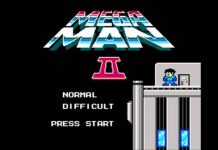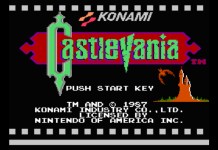Out of the way Joe Musashi! One side Grey Fox! Crawl back under your rock Goemon! It’s time to make way for the most dangerous and revered shinobi to ever strike a home console… No, I’m not talking about Strider Hiryu! This is the one, the only, the oft imitated, but never duplicated, RYU HAYABUSA!!!
Slashing his way onto home consoles in the winter of 1988 in Japan, the unstoppable ninja came overseas in early 1989 managing to maximize on the ninja craze that had taken the States (although, I sincerely doubt a certain mutant foursome would have stood much of a chance against this bruiser). Skyrocketing the bar when it comes to combat systems, introducing cinematic cut scenes to the home console, and creating a brand that would go on to become a legend in the gaming world are just some of the feats this Ninja Gaiden is known for. Now, before we get too far, let me give you some background on this gem.
Originally titled Ninja Ryūkenden, or Ninja Dragon Sword Legend, the title was changed to Ninja Gaiden during localization. Interestingly, it should be noted that an arcade version was also released around the same time, but despite the games sharing the same name and hero, they are not ports of one another. Instead, the arcade version is a beat ‘em up while the NES version is a platformer. The only other similarity between the two is that they share the same, or a very similar, first stage.
According to gaming lore, lead developer Masato Kato changed the title from Ryūkenden to Gaiden because he felt “it sounded cool.” Oddly, this discounts the fact that “Gaiden” literally means “side-story” and is often attached to games that are not considered part of the main canon for a series, such as Metal Gear Solid: Ghost Babel, Resident Evil Gaiden, and Gundam 0079: Rise From the Ashes. There was also the European title change to Shadow Warriors due to their ban on anything ninja related… Teenage Mutant Hero Turtles being one of the region’s most infamous changes. Whatever the reasoning, Kato and game director, Hideo Yoshizawa, had a hit on their hands and the series has continued, breaking onto modern consoles in 2005 with a brand new iteration.
Yoshizawa, working under the name Sakurazaki, not only directed the game, but was responsible for the creation of Ryu Hayabusa and writing the story. Kato himself provided the in-game graphics, the animations for the cut scenes, and the illustrations for the instruction manual. When designing Ryu, Yoshizawa chose a vest that, while giving the look of a karate gi, would show off the ninja’s muscular arms, and make him stand out in comparison to other video game shinobi. In regards to his hooded cowl, the designer arched it back to give a sleek appearance that would simulate the mythical speed with which ninja moved. As for the hero’s color scheme, the dark blue makes him stand out in contrast to the variety of light and dark colored backgrounds. As with Mega Man, it seems as if the team attempted to use every color available in the NES pallet.
Admittedly, both men stated that they were heavily inspired by Nintendo’s Super Mario Bros. and Konami’s Castlevania. While not a clone of either game, the similarities can easily be seen. Then again, when it comes to Mario, almost any game that came out at that time could be said to have been inspired by the turtle smashing Italian. They say imitation is the sincerest form of flattery, but in this case it goes much further beyond that.
Skipping past the Mario aspects, the unique combat system and iconic weaponry is an obvious nod to Castlevania. Ryu is armed with a katana, in this case the legendary Dragon Sword, and several sub-weapons, which become invaluable to maneuver past swarms of enemies whilst relying on expert timing couple with a steep and unforgiving learning curve. It’s a personal opinion, but I feel that Ninja Gaiden is actually a stronger game than its inspirations, especially with the addition of ninpō, defined as unconventional warfare, or as it’s more commonly known, jutsu. The ninpō skills included here make navigating through the endless waves of respawning enemies much easier, so long as you have the skill points, or Spiritual Strength, to meet the casting cost.
Let’s take a closer look at Ryu’s arsenal, starting with the Dragon Sword. The blue clad ninja’s main weapon is kept sheathed as he moves across the screen, only coming out to dispatch the nearest enemy. Remember that expert timing I mentioned? Well, using the katana falls under that particular umbrella as pressing the attack button does not immediately cause our hero to strike. There is an extremely minute delay after pressing the B button that can be the difference between splitting a foe in twain and taking a rather devastating hit. This might aggravate some players, but rest assured, it adds to the experience and looks awesome.
In addition to his main weapon, Ryu can also use the Ninja Arts, comprised of sub-weapons and mystical abilities hidden in lanterns, orbs, low flying bugs, and even candles (another quick nod to Castlevania).

The sub-weapons available are the Throwing Star, or Shuriken, which can be thrown horizontally across the screen in either direction and the Windmill Throwing Star, which returns to Ryu after being thrown and will continue to fly back and forth until he catches it.
The next three items are actually categorized as ninpō due to the mystical nature surrounding them in comparison to being actual weapons. The Art of the Flying Fire Wheel grants Ryu the ability to launch three fireballs circling upwards. Then there’s the Art of the Invincible Fire Wheel, which creates a shield of rotating fireballs making Ryu temporarily invulnerable.

Lastly, the Jump & Slash Technique gives the devastating ability to slash while flipping through the air. Just be vigilant of how much Spiritual Strength each use takes. Everything except the basic Throwing Star costs five points to use and the game is not very sparing when it comes to providing players with them. Add into it the fact that dying cuts your Spiritual Strength in half with each death.
And speaking of dying, prepare to do it… a lot. I know I’ve said this in past articles and it appears to be a running theme, but seriously, you are going to die. Sometimes over and over and over again from the same damn thing. Sometimes it’s a suddenly respawning enemy, sometimes it’s a lucky hit from a projectile, sometimes you hit the jump button just a little too soon and flip straight into a pit, or sometimes it’s a freaking bird! No, I’m not even playing here, the most powerful and annoying enemies are the homicidal birds inhabiting later stages. These things are worse than any other enemy, aside from the bosses, in the entire game and they will hound you until you either kill them or manage to get them off screen. During one particularly painful play through, I died no less than ten times from the same damn bird! I took great pleasure it devouring my chicken dinner that night…






























